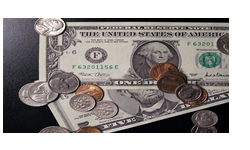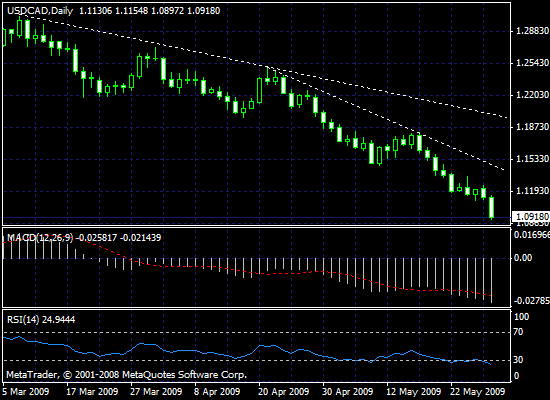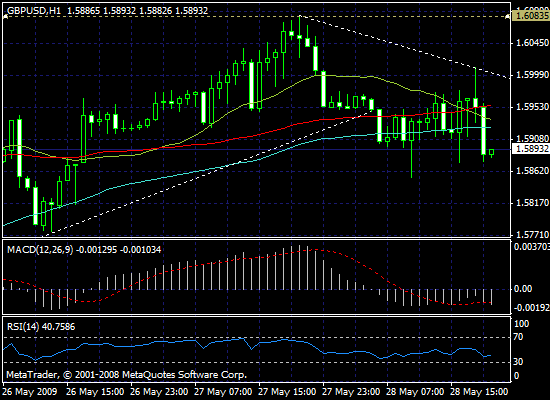By GCI Fx Research
€
The euro strengthened sharply vis-à-vis the U.S. dollar today as the single currency tested offers around the US$ 1.4165 level and was supported around the US$ 1.3925 level. The common currency reached its highest level since 30 December as traders dumped U.S. dollars ahead of the U.S.-Sino summit in China. There is growing concern the U.S. may lose its “AAA” credit rating even though Moody’s Investors Service maintained its credit rating this week. The U.S. government now owes a record US$ 63.8 trillion. Many data were released in the U.S. today. The University of Michigan final May consumer sentiment indicator improved to 68.7, up from 65.1 at the end of April. Also, first quarter gross domestic product contracted 5.7% while the real personal consumption expenditures index was up 1.5%. The 5.7% contraction was better than the 6.3% decline in the fourth quarter. Additionally, the May Chicago PMI fell to 34.9 from 40.1 in April. In eurozone news, French unemployment worsened in April while the May flash eurozone inflation rate was 0.0% y/y, off 0.6% m/m. EMU-16 April private sector loan growth eased to 2.4% from 3.2% in March while the annual M3 money supply growth rate was off to 4.9% in April from 5.0% in March. European Central Bank member Draghi said the chances of eurozone deflation “now appear slight.” Other data saw German April retail sales climb +0.5% m/m and fall 0.8% y/y. Euro bids are cited around the US$ 1.3435 level.
¥/ CNY
The yen appreciated vis-à-vis the U.S. dollar today as the greenback tested bids around the ¥95.20 level and was capped around the ¥97.00 figure. Many data were released in Japan overnight. April construction orders were off 25.9% y/y to ¥562.8 billion while the trade deficit printed at ¥24.62 billion between 1 – 10 May. Also, April industrial output was up 5.2% m/m and off 31.2% y/y. Other data saw April core consumer price inflation off 0.1% y/y, consistent with expectations. Bank of Japan’s Policy Board is expected to keep its monetary policy unchanged for the foreseeable future, especially after upgrading its assessment of the economy earlier this week. The Nikkei 225 yesterday stock index climbed 0.75% to close at ¥9,522.50. U.S. dollar offers are cited around the ¥104.15 level. The euro moved lower vis-à-vis the yen as the single currency tested bids around the ¥134.25 level and was capped around the ¥135.70 level. The British pound moved lower vis-à-vis the yen as sterling tested bids around the ¥153.25 level while the Swiss franc moved lower vis-à-vis the yen and tested offers around the ¥88.90 level. In Chinese news, the U.S. dollar closed at CNY 6.8273 in the over-the-counter market. Treasury Secretary Geithner travels to China this weekend and meets with leading Chinese officials on Monday. Treasury officials said the Obama administration is “attuned to the interests of our investors and plan to listen closely to what they have to say.” The Chinese government has recently been critical of the effects of U.S. policy and how they impact the value of China’s massive foreign reserves, about 70% of which are said to be denominated in U.S. dollars. The Treasury also said the “U.S. dollar will continue to play a very important role for a very long time.”
₤
The British pound appreciated sharply vis-à-vis the U.S. dollar today as cable tested offers around the US$ 1.6195 level and was supported around the $1.5915 level. Data released in the U.K. today saw May Nationwide housing prices rise 1.2% and fall 11.3% y/y. Also, May GfK NOP consumer confidence was steady at -27, unchanged from April. Cable bids are cited around the US$ 1.5535 level. The euro appreciated vis-à-vis the British pound as the single currency tested offers around the ₤0.8800 figure and was supported around the ₤0.8705 level.
CHF
The Swiss franc appreciated vis-à-vis the U.S. dollar today as the greenback tested bids around the CHF 1.0655 level and was capped around the CHF 1.0860 level. Data released in Switzerland today saw the May KOF leading indicator remained unchanged at -1.86. U.S. dollar offers are cited around the CHF 1.0975 level. The euro and British pound weakened vis-à-vis the Swiss franc as the crosses tested bids around the CHF 1.5075 and CHF 1.7150 levels, respectively.
Daily Market Commentary provided by GCI Financial Ltd.
GCI Financial Ltd (”GCI”) is a regulated securities and commodities trading firm, specializing in online Foreign Exchange (”Forex”) brokerage. GCI executes billions of dollars per month in foreign exchange transactions alone. In addition to Forex, GCI is a primary market maker in Contracts for Difference (”CFDs”) on shares, indices and futures, and offers one of the fastest growing online CFD trading services. GCI has over 10,000 clients worldwide, including individual traders, institutions, and money managers. GCI provides an advanced, secure, and comprehensive online trading system. Client funds are insured and held in a separate customer account. In addition, GCI Financial Ltd maintains Net Capital in excess of minimum regulatory requirements.
DISCLAIMER: GCI’s Daily Market Commentary is provided for informational purposes only. The information contained in these reports is gathered from reputable news sources and is not intended to be U.S.ed as investment advice. GCI assumes no responsibility or liability from gains or losses incurred by the information herein contained.






